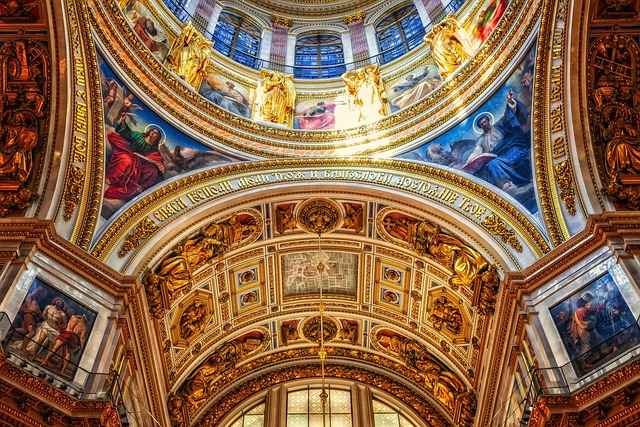Orthodox Christianity traces its origins back to the early days of Christianity, specifically to the time of Jesus Christ and his apostles. It emerged as one of the major branches of Christianity, alongside Roman Catholicism and Protestantism. The term “Orthodox” comes from the Greek word “orthodoxia,” meaning “right belief” or “correct worship.” The development of Orthodox Christianity can be attributed to various historical, theological, and cultural factors, including the early Christian communities in the Eastern Mediterranean, the Councils of Nicaea and Chalcedon, and the influence of Byzantine culture.
Table of Contents
The Origins of Orthodox Christianity: A Historical Overview
Orthodox Christianity, one of the oldest branches of Christianity, has a rich and fascinating history that dates back to the time of Jesus Christ. In this article, we will take a historical overview of how Orthodox Christianity started and the key events that shaped its development.
The origins of Orthodox Christianity can be traced back to the life and teachings of Jesus Christ in the first century AD. Jesus, who is considered the Son of God by Orthodox Christians, preached a message of love, forgiveness, and salvation. His teachings attracted a large following, and his disciples became the first leaders of the early Christian community.
After Jesus’ crucifixion and resurrection, his disciples spread his message throughout the Roman Empire and beyond. They established communities of believers and appointed bishops to oversee these communities. These bishops, known as apostles, were seen as the successors of the original twelve disciples and held authority over the local churches.
Over time, the Christian community grew and faced various challenges. One of the most significant challenges was the rise of heresies, which were teachings that deviated from the orthodox beliefs. These heresies threatened to divide the Christian community, and in response, church leaders convened several ecumenical councils to address these issues.
The first ecumenical council, known as the Council of Nicaea, took place in 325 AD. It was called to address the Arian heresy, which denied the divinity of Jesus Christ. The council affirmed the orthodox belief in the Holy Trinity and declared that Jesus was of the same substance as God the Father. This council laid the foundation for the Nicene Creed, which is still recited in Orthodox Christian liturgy today.
Another important council was the Council of Chalcedon in 451 AD. This council addressed the issue of the nature of Christ, specifically the question of whether he had one nature (monophysitism) or two natures (dyophysitism). The council affirmed the orthodox belief that Christ had two natures, fully human and fully divine, united in one person.
As the Roman Empire declined, the Christian Church faced new challenges. In 1054 AD, a major schism occurred between the Eastern Orthodox Church and the Roman Catholic Church. This event, known as the Great Schism, was the result of theological, political, and cultural differences between the two branches of Christianity. The schism led to the formation of two distinct Christian traditions: Eastern Orthodoxy and Roman Catholicism.
Despite the schism, Orthodox Christianity continued to flourish in the Byzantine Empire, which was the successor to the Roman Empire in the East. The Byzantine Empire became the center of Orthodox Christian culture and theology, producing influential theologians and scholars.
In the 15th century, the Byzantine Empire fell to the Ottoman Turks, and Orthodox Christians came under Muslim rule. This period of Ottoman rule was marked by persecution and restrictions on the practice of Christianity. However, Orthodox Christianity survived and continued to be a vital part of the cultural and religious identity of the Eastern European and Middle Eastern regions.
In the modern era, Orthodox Christianity has spread beyond its traditional territories and has become a global faith. Today, there are millions of Orthodox Christians around the world, with significant communities in Eastern Europe, Russia, the Middle East, and North America.
In conclusion, Orthodox Christianity has a long and storied history that began with the teachings of Jesus Christ and the early Christian community. Through the challenges of heresies, ecumenical councils, and the Great Schism, Orthodox Christianity has remained steadfast in its beliefs and traditions. Today, it continues to be a vibrant and influential branch of Christianity, with a rich cultural heritage and a global presence.
Key Figures and Events in the Early Development of Orthodox Christianity

Orthodox Christianity, one of the oldest branches of Christianity, has a rich history that dates back to the early days of the faith. In this article, we will explore the key figures and events that played a crucial role in the early development of Orthodox Christianity.
One of the most significant figures in the early history of Orthodox Christianity is Saint Peter, one of the twelve apostles of Jesus Christ. According to tradition, Peter was chosen by Jesus to be the leader of the apostles and the foundation of the Church. His teachings and leadership laid the groundwork for the establishment of the Christian faith.
Another important figure in the early development of Orthodox Christianity is Saint Paul. Originally a persecutor of Christians, Paul underwent a profound conversion experience and became one of the most influential apostles. His missionary journeys and letters to various Christian communities played a crucial role in spreading the teachings of Jesus and establishing the early Christian Church.
The Council of Nicaea, held in 325 AD, was a pivotal event in the history of Orthodox Christianity. This council was convened by Emperor Constantine to address the Arian controversy, a theological dispute regarding the nature of Jesus Christ. The council affirmed the divinity of Jesus and formulated the Nicene Creed, which remains a central statement of faith for Orthodox Christians to this day.
Another key event in the early development of Orthodox Christianity was the Great Schism of 1054. This event marked the formal split between the Eastern Orthodox Church and the Roman Catholic Church. The primary points of contention were theological differences, as well as disputes over authority and jurisdiction. The Great Schism had a lasting impact on the Christian world, leading to the establishment of two distinct branches of Christianity.
Throughout its history, Orthodox Christianity has been shaped by numerous influential theologians and thinkers. One such figure is Saint Athanasius, a fourth-century bishop who played a crucial role in defending the divinity of Jesus Christ against the Arian heresy. His writings and teachings continue to be highly regarded within the Orthodox tradition.
Another important theologian in the early development of Orthodox Christianity is Saint John Chrysostom. Known for his eloquent preaching and moral teachings, Chrysostom served as the Archbishop of Constantinople in the late fourth century. His sermons and writings emphasized the importance of living a virtuous life and caring for the poor, leaving a lasting impact on the Orthodox Church.
In conclusion, the early development of Orthodox Christianity was shaped by key figures and events that laid the foundation for the faith. From the apostles Peter and Paul to the Council of Nicaea and the Great Schism, these individuals and events played a crucial role in shaping the beliefs and practices of Orthodox Christians. The teachings of influential theologians like Athanasius and Chrysostom continue to guide the faithful to this day. Orthodox Christianity’s rich history is a testament to the enduring power of the faith and its ability to adapt and thrive throughout the centuries.
The Councils and Doctrinal Foundations of Orthodox Christianity
Orthodox Christianity, one of the oldest branches of Christianity, has a rich history that dates back to the early days of the Church. Its origins can be traced back to the Councils and Doctrinal Foundations that were established in the early centuries of Christianity.
The Councils played a crucial role in shaping the beliefs and practices of Orthodox Christianity. These gatherings brought together bishops and theologians from different regions to discuss and debate important theological issues. The first Council, known as the First Council of Nicaea, was held in 325 AD. It was during this Council that the Nicene Creed, a statement of faith that is still recited by Orthodox Christians today, was formulated.
The Councils continued to meet over the years, addressing various theological controversies that arose within the Church. One of the most significant Councils was the Council of Chalcedon in 451 AD. This Council affirmed the belief in the dual nature of Christ, that he was both fully human and fully divine. This doctrine, known as the Chalcedonian Definition, became a cornerstone of Orthodox Christology.
In addition to the Councils, the early Church Fathers played a crucial role in establishing the doctrinal foundations of Orthodox Christianity. These theologians, such as St. Athanasius and St. John Chrysostom, wrote extensively on matters of faith and helped to articulate the beliefs of the Church. Their writings, known as the Patristic literature, continue to be studied and revered by Orthodox Christians today.
One of the key doctrinal foundations of Orthodox Christianity is the belief in the Holy Trinity. Orthodox Christians believe in one God who exists in three persons: the Father, the Son (Jesus Christ), and the Holy Spirit. This belief is based on the teachings of Jesus and the writings of the early Church Fathers.
Another important aspect of Orthodox Christianity is its emphasis on the sacraments. The sacraments, such as baptism and the Eucharist, are seen as tangible ways in which God’s grace is imparted to believers. These sacraments are considered essential for the spiritual growth and salvation of individuals.
Orthodox Christianity also places a strong emphasis on the veneration of icons. Icons are religious images that are used as aids in worship and prayer. They are seen as windows into the divine and are believed to have the power to connect believers with the spiritual realm. The use of icons has been a source of controversy throughout history, but they continue to hold a central place in Orthodox worship.
In conclusion, the Councils and Doctrinal Foundations of Orthodox Christianity have played a vital role in shaping the beliefs and practices of this ancient branch of Christianity. Through the Councils, important theological issues were addressed and key doctrines were established. The writings of the early Church Fathers further contributed to the development of Orthodox theology. Today, Orthodox Christians continue to hold firm to these doctrinal foundations, cherishing the rich history and traditions that have been passed down through the centuries.
Spread and Influence of Orthodox Christianity: From Byzantium to the Modern World
Orthodox Christianity, one of the oldest branches of Christianity, has a rich and fascinating history that spans over two thousand years. Its origins can be traced back to the early days of the Christian faith, when the teachings of Jesus Christ began to spread throughout the Roman Empire.
The spread of Orthodox Christianity can be attributed to a variety of factors. One of the most significant was the conversion of Emperor Constantine to Christianity in the 4th century. This event not only legitimized the faith but also allowed for its rapid expansion throughout the empire. With the emperor’s support, Christian churches were built, and the religion was able to flourish.
Another important factor in the spread of Orthodox Christianity was the establishment of the Byzantine Empire. After the fall of the Western Roman Empire, the Eastern Roman Empire, also known as the Byzantine Empire, became the center of Orthodox Christianity. The Byzantine emperors played a crucial role in promoting and protecting the faith, and their influence extended far beyond the borders of their empire.
During this time, Orthodox Christianity began to take on a distinct identity. It developed its own liturgical traditions, theological doctrines, and hierarchical structure. The Byzantine Empire became a beacon of Orthodoxy, and its influence spread to neighboring regions, such as Russia, Bulgaria, and Serbia.
In the 9th century, a major schism occurred between the Eastern Orthodox Church and the Roman Catholic Church. This event, known as the Great Schism, marked a significant turning point in the history of Orthodox Christianity. The split was primarily due to disagreements over theological and administrative matters, as well as cultural and political differences between the East and the West.
Despite the schism, Orthodox Christianity continued to thrive and exert its influence. In the following centuries, Orthodox missionaries traveled to various parts of the world, spreading the faith to new territories. They established churches, translated religious texts, and converted local populations to Orthodoxy.
One of the most notable examples of Orthodox Christianity’s spread is its impact on the Slavic peoples. Saints Cyril and Methodius, two Byzantine missionaries, developed the Cyrillic alphabet and translated the Bible into Old Church Slavonic. This allowed for the dissemination of Orthodox teachings among the Slavic peoples, who eventually adopted the faith as their own.
Orthodox Christianity also played a significant role in the formation of modern Russia. The Russian Orthodox Church became deeply intertwined with the country’s identity and culture. It served as a unifying force, providing spiritual guidance and moral support to the Russian people.
Today, Orthodox Christianity continues to be a major religious tradition with millions of followers worldwide. It has adapted to the modern world while preserving its ancient traditions and teachings. Orthodox churches can be found in countries across the globe, from Greece and Romania to the United States and Australia.
In conclusion, the spread and influence of Orthodox Christianity from Byzantium to the modern world is a testament to its enduring power and significance. From its humble beginnings in the Roman Empire to its establishment as the dominant faith in the Byzantine Empire, Orthodox Christianity has left an indelible mark on history. Its teachings and traditions continue to shape the lives of millions of believers, making it a vibrant and dynamic religious tradition.
Conclusion
In conclusion, Orthodox Christianity originated from the early Christian Church and developed into a distinct branch of Christianity. It was influenced by various factors, including the teachings of Jesus Christ, the apostles, and the early Church Fathers. The Great Schism of 1054 marked the formal split between the Eastern Orthodox Church and the Roman Catholic Church, solidifying the separate identity of Orthodox Christianity. Over the centuries, Orthodox Christianity has spread and evolved, becoming a significant religious tradition with its own distinct beliefs, practices, and organizational structure.
For licensing reasons, we must provide the following notice: This content was created in part with the help of an AI.


